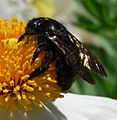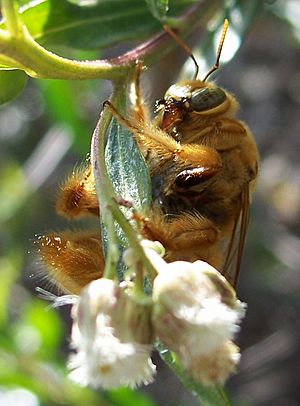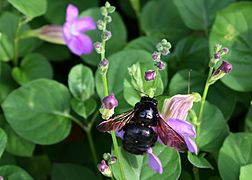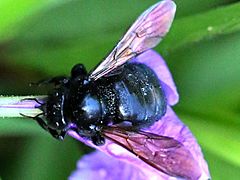Valley carpenter bee facts for kids
Quick facts for kids Valley carpenter bee |
|
|---|---|
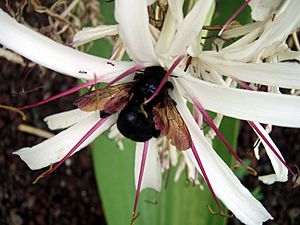 |
|
| Female Xylocopa sonorina | |
| Scientific classification | |
| Genus: |
Xylocopa
|
| Species: |
sonorina
|
| Synonyms | |
|
Xylocopa varipuncta Patton, 1879 |
|
The valley carpenter bee, also called the Hawaiian carpenter bee, is a type of carpenter bee. Its scientific name is Xylocopa sonorina. You can find these bees from western Texas to northern California, and on islands in the eastern Pacific Ocean. Female valley carpenter bees are black. The males are golden-brown and have green eyes.
Contents
About Valley Carpenter Bees
What's in a Name?
The valley carpenter bee, X. sonorina, is one of three types of Xylocopa bees found in the southwestern United States. The Xylocopa group has about 500 different species around the world.
A scientist named Frederick Smith first described X. sonorina in 1874. He studied bees collected in Hawaii. For a long time, people thought this bee came from the Sunda Islands. But in 1956, another scientist, M. A. Lieftinck, showed that Smith had made a mistake. The bee actually came from the Sandwich Islands, which are now known as the Hawaiian Islands.
Later, in 1899, another scientist named R. C. L. Perkins described the same bee. He called it Xylocopa aeneipennis. In 1922, P. H. Timberlake said the Hawaiian Xylocopa was the same as a bee from the mainland called X. varipuncta. This bee was named in 1879. In 2003, Roy Snelling thought that X. varipuncta would eventually be called the same as X. sonorina. This was proven true in 2020 using DNA tests. Since sonorina was the older name, it is now the official name for this bee.
How to Spot a Valley Carpenter Bee
Valley carpenter bees are some of the biggest bees in California and Hawaii. They can grow to be about 1 inch (2.5 cm) long.
Here's how you can tell them apart:
- Females are all black. Like most native bees, they are not aggressive. They will usually only sting if they feel threatened.
- Males are golden-brown. They do not have stingers at all. Male bees have a special gland in their chest. This gland makes chemicals called pheromones that attract females.
-
A female bee covered in pollen on a passionflower.
Where Valley Carpenter Bees Live
You can mostly find these bees in the southwestern United States. This includes Arizona, California, New Mexico, Nevada, Texas, and Utah. They also live in nearby parts of Mexico. On the mainland, they like valleys and foothills with deciduous trees, especially oaks.
The valley carpenter bee is also one of 11 types of bees that are not native to Hawaii. People believe that humans helped these bees travel to the Pacific islands. We don't know exactly when X. sonorina arrived in the Hawaiian Islands. But it was there before 1874, when Frederick Smith first named the species. Today, you can find X. sonorina on all the main Hawaiian Islands. They are also found in the Mariana Islands.
Hawaii is more than 2,000 miles (3,200 km) from North America. This distance is too far for bees to travel naturally. So, it's very likely that humans helped X. sonorina get to Hawaii. After reaching Hawaii, X. sonorina was also taken to the Marianas Islands, China, and Japan. However, these attempts to introduce them were not successful. There have also been reports of these bees in Midway Atoll, Java, New Guinea, and the Philippines. But only the reports from Midway have actual bee samples to prove it.
Only two other Xylocopa species have successfully reached Pacific islands east of the Americas. This happened either naturally or with human help. There are over 150 identified species in North and South America. For example, 70 of them are found in Brazil alone. One of these two species is Xylocopa darwini, found in the Galápagos Islands. These islands are 604 miles (972 km) west of South America. The closest land is Ecuador. The other species is Xylocopa clarionensis, found on Clarión Island in the Revillagigedo Islands. This island is 700 miles (1,100 km) from the coast of Mexico. X. clarionensis is thought to be very similar to Xylocopa sonorina.
Life Cycle and Reproduction
In the spring, female bees mate with males. After mating, they might fly off to start new nests. Or, they might clean out and make bigger the old tunnels they used during the winter. They then add special "brood cells" for their young.
Each cell a female bee prepares contains something called "bee bread." This is a mix of pollen and nectar. It's food for the baby bees, called larvae. The female lays one egg on the bee bread. She then seals the cell with a wall made of sawdust. She might lay several eggs, each in its own cell, in a row inside the tunnel. The eggs hatch in about two to three days. The larvae grow for about two weeks. Then they become pupae, and after three to four weeks, they become adult bees. Young adult male and female bees spend the winter resting in these tunnels.
Behavior of Valley Carpenter Bees
Female Behavior and Nesting
Young female bees might fly around to explore and find food. They are attracted to things they see and smell. When a female is looking for a mate, she might wait for a male at a flower where she finds his scent marks. Or, she might fly directly to a marked spot from far away.
Carpenter bees get their name because they build their nests inside wood. The common name "valley carpenter bee" comes from the Californian Central Valley, where they are often found. Like their relatives, such as the Eastern carpenter bee, X. sonorina likes to nest in wooden fence posts, telephone poles, and parts of buildings.
The bees use their strong mouthparts to dig tunnels in the wood. They don't eat the wood. They also tend to avoid wood that is painted or stained. The tunnels are usually about 6 to 10 inches (15 to 25 cm) long. They have a line of separate cells for their young. Adult bees spend the winter inside these tunnels. Most X. sonorina nests have one female bee and her young.
Carpenter bees are not aggressive. They protect their nests by building strong cell walls. They also block the nest entrance in different ways. Sometimes, they cover the cell walls with liquids. If a parasite attacks the nest, they might sacrifice all the young bees to protect the nest.
A scientist named Julian R. Yates III from the University of Hawaii at Manoa described the life cycle of X. sonorina in Hawaii: "Once a female bee finds a good piece of wood, she starts digging a tunnel to lay her eggs. Because Hawaii has a warm climate, female carpenter bees lay eggs all year. But they might lay fewer eggs in the winter when the weather is not as good. Before laying eggs, the female collects pollen. She puts it in a ball at the very end of the tunnel. She lays one egg on the pollen ball. Then she seals the egg and pollen in a chamber using wood shavings. She might lay several eggs, each with its own pollen ball and sealed chamber, in a line inside the tunnel. The eggs hatch in two to three days. The larvae grow for about two weeks. The next stages, called prepupal and pupal, take about three to four weeks to become adult bees. Young female bees are fed by their mother. They can buzz in about a week and fly in about two to three weeks. Sometimes, a single female in a tunnel might be joined later by her offspring or other bees. But only one female will collect pollen, prepare cells, and lay eggs. Other females will guard the nest and keep it clean."
Pollination and Foraging
Flowers are the only source of food and water for these bees. They visit certain plants at different times of the day. Females collect pollen for their young. To get pollen from most flowers, females gather it on their back legs by touching the parts of the flower that hold pollen. But in flowers with closed pollen parts, like some nightshade plants, they can use "buzz pollination." This is where the bee vibrates its flight muscles to shake the pollen out of the flower.
When X. sonorina bees look for food, they move quickly between flowers. In one study, a bee visited 16 flowers per minute. It spent about 1.5 seconds at each flower. It usually flew to the front of the flower, landed on the petals, and moved to the bottom part. Another study found that X. sonorina sometimes "robs" nectar from flowers. This means they make holes near the bottom of long, tube-shaped flowers to get nectar. But they don't pollinate the flower in return because their tongues are too short to reach the nectar normally.
-
A female bee robbing nectar in Hawaii.
Some flowers protect themselves from nectar robbers. They might have strong walls or produce extrafloral nectar. This extra nectar attracts ants that stop the bees from robbing. However, ant guards only work against certain bee species, not Xylocopa.
In Hawaii and Niue Island, X. sonorina bees have been used to help pollinate Passiflora edulis, a type of passion fruit. Even though they are good pollinators, carpenter bees' nesting habits can make them seem like pests. This is because they like to dig into wood to make their nests. Because of this problem, in 1934, a type of blister beetle was brought to Hawaii. The idea was to reduce the number of X. sonorina bees. But there is no proof that this beetle became established there.
Male Behavior and Attraction
Male X. sonorina bees try to find the best places to attract mates. They use a strategy called "ideal free distribution." This means the strongest males try to get the best areas. Weaker males have to settle for less good areas until all areas are taken. For these bees, some areas are better because more females might visit them. Males might use clues from their environment, not just food, to choose their areas.
The large gland in the chest of male X. sonorina bees makes special chemicals called pheromones. These pheromones attract females from a distance. They act like advertisements for the males. This gland is only active during certain seasons. Males that have spent the winter resting don't make these attractants. X. sonorina males mark the center of their areas with these pheromones. Scientists observed three things that led to this idea:
- Flying bees sometimes brush against leaves or twigs near the center of their area.
- Males land and walk around in the main area, applying the pheromone.
- Females fly to and pause on non-flowering plants where a male had marked his area with the attractant.
Territory and Staying in One Place
Males of X. sonorina often don't stay in the same territory for long. However, a few males show a strong attachment to their original spots. Many things can affect how long a male stays in one place. If many males die, new males will take over territories more often. Also, if there are many males but not enough good territories, competition increases. This leads to males changing territories more often. On the other hand, if there are not many new males to take over, males will stay in their territories longer.
The quality of the territory also matters. If a territory becomes less valuable for attracting females, males are expected to leave it. It's also possible that the quality of a male's pheromone is very important in how attractive he is to females.
How Valley Carpenter Bees Control Their Body Temperature
Valley carpenter bees have a special ability to control their body temperature. They can fly in very hot weather without overheating. They can also fly in cold weather without freezing. This is unusual compared to other bee species. They change how they look for food and fly at different heights depending on the temperature. This helps them live in very different environments.
Xylocopa sonorina bees keep their chest temperature between 33.0 and 46.5 °C. They do this even when the air temperature is between 12.0 and 40.0 °C. This shows they are actively controlling their temperature. When they warm up before flying, they move a lot of heat to their abdomen and head. The head gets warmer because heat simply moves to it. The abdomen gets warmer because the bee actively moves heat there.
Xylocopa bees have a blood circulation system similar to honeybees and bumblebees. Like bumblebees, they have a loop in their main blood vessel that goes through their flight muscles. This loop acts like a cooling coil. It allows heat to transfer to their blood, head, and abdomen.
Carpenter bees have large heads. This gives them a bigger surface area to cool down. Their abdomen is also good at losing heat quickly because it is flat and not insulated. So, even if heat moves to the head or abdomen, it might not be obvious from body temperature readings. This is because these parts cool down fast, especially in hot air when the bee flies faster. Controlling their temperature involves relying a lot on cooling from air movement. They also actively move heat to their abdomen and lose water through their head at high temperatures.
See also
 In Spanish: Abeja carpintera de Sonora para niños
In Spanish: Abeja carpintera de Sonora para niños




